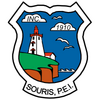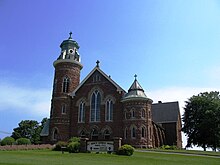| This article needs additional citations for verification. Please help improve this article by adding citations to reliable sources. Unsourced material may be challenged and removed. Find sources: "Souris, Prince Edward Island" – news · newspapers · books · scholar · JSTOR (September 2017) (Learn how and when to remove this message) |
| Souris | |
|---|---|
| Town | |
| Town of Souris | |
 Aerial view in 2024 Aerial view in 2024 | |
 Flag Flag Seal Seal | |
 | |
| Coordinates: 46°21′19″N 62°15′15″W / 46.35540°N 62.25416°W / 46.35540; -62.25416 | |
| Country | Canada |
| Province | Prince Edward Island |
| County | Kings County |
| Founded | 1740 |
| Incorporated Town | November 14, 1910 |
| Government | |
| • Type | Town Council |
| • Mayor | Jo-Anne Dunphy |
| • Deputy Mayor | Boyd Leard |
| • CAO | Shelley LaVie |
| Area | |
| • Total | 3.47 km (1.34 sq mi) |
| Highest elevation | 13 m (43 ft) |
| Lowest elevation | 0 m (0 ft) |
| Population | |
| • Total | 1,053 |
| • Density | 303.7/km (787/sq mi) |
| Time zone | UTC-4 (AST) |
| • Summer (DST) | UTC-3 (ADT) |
| Canadian Postal code | C0A |
| Area code | 902 |
| Telephone Exchange | 208 215 327 687 743 |
| NTS Map | 011L08 |
| GNBC Code | BACII |
| Website | www |
Souris is a town in Kings County, Prince Edward Island, Canada. It is located near the northeastern tip of the province.
History

Souris was founded by Acadians in 1727 as a fishing settlement at the mouth of the Souris River. These early settlers experienced several plagues of field mice in the surrounding area during the 1720s-1760s which damaged crops. Souris is French for "mouse" and a mouse is the town's mascot. It is said that "a French vessel passing by the bay in the early 1700s was forced to cut through the waves of drowned mice and so gave the name to the area. The 1744 map of Sieur de la Roque names the bay, Havre a la Souris”. Earlier names also included: Colville Bay, Grand Haven, New Bristol, and Red Cliffs.
The name likely also shares similar roots with the Souriquois and the Souris River. The French (Acadians) came to call the Micmacs the Souriquois, adopting the Indians' pidgin word for the trade language. "The term came from the Basque zurikoa (pronounced “surikoa”) meaning “that of the whites.” The -koa ending would be a Basque suffix denoting geographic origin and giving the word the meaning “people from Souris.”
The Mi'kmaq (Mi'kmaw, Micmac or L'nu, “the people” in Mi'kmaq) were the first inhabitants in the area and had an encampment at the head of the Souris River. Several Acadian families arrived in 1740 as the first white settlers but were forced out by the British after the Siege of Louisbourg (1758). In 1765, the British government divided the island into 67 lots, Souris being lot #45 and 20,000 acres. The first census was carried out in 1798 and did not include any settlers in Souris, despite 1996 government record stating that "Scottish settlers came to the area as early as 1772, and English and Irish settlers arrived around 1810".
20th century and beyond
Souris was incorporated into PEI on November 14, 1910.
The town has many well-preserved historic buildings, including the Matthew and MacLean Building, Souris Customs House and Post Office, and the McQuaid Building.
Souris has a well-developed harbor for fishing boats and boat repair. Since the 1960s, Souris has hosted an interprovincial ferry terminal for the service to Quebec's Magdalen Islands. The MV Madeleine II is operated by the Coopérative de transport maritime et aérien (CTMA).
Geography
As of 2016, the land area is 3.47 square kilometres. The Town of Souris website states that "Prince Edward Island is part of the Appalachian Region which runs from southern Quebec and Gaspésie and includes New Brunswick, Nova Scotia, Prince Edward Island and Newfoundland. There are many physiographic units with a peneplain that slopes from the highest point in the northwest down in a southeastward manner towards the ocean. The Prince Edward Island physiographic region is part of the Maritime Plain. The Maritime Plain runs around the coast of New Brunswick and Nova Scotia from the south shore of Chaleur Bay and includes Prince Edward Island and Îles-de-la-Madeleine."
Economy
The economy of the area is dominated by the seasonal industries of fishing and oysters, agriculture and tourism. There are also several industrial businesses and a good retail sector. The town is home to banks, pharmacies, cafés, restaurants, gas stations, a grocery store, and other independent businesses.
Demographics
| Year | Pop. | ±% |
|---|---|---|
| 1901 | 1,140 | — |
| 1911 | 1,089 | −4.5% |
| 1921 | 1,094 | +0.5% |
| 1931 | 1,063 | −2.8% |
| 1941 | 1,114 | +4.8% |
| 1951 | 1,183 | +6.2% |
| 1956 | 1,449 | +22.5% |
| 1961 | 1,537 | +6.1% |
| 1966 | 1,443 | −6.1% |
| 1971 | 1,393 | −3.5% |
| 1976 | 1,447 | +3.9% |
| 1981 | 1,413 | −2.3% |
| 1986 | 1,379 | −2.4% |
| 1991 | 1,333 | −3.3% |
| 1996 | 1,293 | −3.0% |
| 2001 | 1,248 | −3.5% |
| 2006 | 1,232 | −1.3% |
| 2011 | 1,173 | −4.8% |
| 2016 | 1,053 | −10.2% |
| 2021 | 1,079 | +2.5% |
| Source: Statistics Canada | ||
In the 2021 Census of Population conducted by Statistics Canada, Souris had a population of 1,079 living in 480 of its 533 total private dwellings, a change of 2.5% from its 2016 population of 1,053. With a land area of 3.61 km (1.39 sq mi), it had a population density of 298.9/km (774.1/sq mi) in 2021.
In 2016, persons aged 14 years and under made up 13.7% of the population, persons 15-64 made up 57.3%, and those aged 65 years and over made up 33.6%. In 2016, 93% of the population had English as their first official language compared to 94.5% for the province as a whole. The same year, 88% of the population were reported to be Canadian citizens in the census. The ethnic origins from most to least listed are: Canadian, Scottish, Irish, English, French, German, North European, Indigenous, Guatemalan, Mexican, and Czech. Roughly 30-34% of the population has a postsecondary certificate, diploma or degree, and roughly 34% of the total labour force population aged 15 years and over was reported to work in natural resources, agriculture and related production occupations, more specifically in the industry categories of agriculture, forestry, fishing and hunting.
Education
Souris is home to two schools, serving grades K-12. Souris Regional School teaches students from grade K-12. Ecole La Belle Cloche is Souris' only Francophone school and teaches students from grades K-12.
École La-Belle-Cloche is situated in what used to be Rollo Bay Consolidated School, three minutes west of Souris in Rollo Bay.
Sports
Souris has venues for soccer, baseball, basketball, rugby, hockey, football, ringette and other similar sports. There are also several parks in Souris.
Kitesurfing is popular in Souris and nearby beaches. Souris Beach is an intermediate-level beach, and has good wave conditions when winds blow from the Southwest. Little Harbour, Basin Head, and other nearby beaches generally have good conditions in southwest and southeast winds.
Gallery
-
The port
-
Ferry terminal
-
Coastline
-
Inside of St. Mary's Church
-
 Nativity scene display
Nativity scene display
-
 Gas station
Gas station
-
 Water tower
Water tower
-
 Church cemetery
Church cemetery
-
 Souris Regional School
Souris Regional School
References
- ^ "Census Profile, 2016 Census: Souris, Town [Census subdivision], Prince Edward Island". Statistics Canada. 8 February 2017. Retrieved October 13, 2019.
- ^ "Municipal Profile - Town of Souris" (PDF). Government of Prince Edward Island. Archived (PDF) from the original on December 14, 2006. Retrieved March 24, 2023.
- ^ "Messamouet (?-1610?) Souriquois headman". Encyclopedia. Gale Research Inc.
- ^ "About". Town of Souris.
- ^ "Census Profile, 2016 Census". Statistics Canada. 8 February 2017.
- "Table 6: Population by census subdivisions, 1901–1961". 1961 Census of Canada (PDF). Series 1.1: Historical, 1901–1961. Vol. I: Population. Ottawa: Dominion Bureau of Statistics. March 8, 1963. Retrieved February 2, 2022.
- "Table 2: Population of Census Subdivisions, 1921–1971". 1971 Census of Canada (PDF). Population. Vol. Census Subdivisions (Historical). Ottawa: Statistics Canada. July 1973. Retrieved February 2, 2022.
- "1976 Census of Canada: Population - Geographic Distributions" (PDF). Statistics Canada. June 1977. Retrieved February 2, 2022.
- "1981 Census of Canada: Census subdivisions in decreasing population order" (PDF). Statistics Canada. May 1992. Retrieved February 2, 2021.
- "1986 Census: Population - Census Divisions and Census Subdivisions" (PDF). Statistics Canada. September 1987. Retrieved February 2, 2022.
- "91 Census: Census Divisions and Census Subdivisions - Population and Dwelling Counts" (PDF). Statistics Canada. April 1992. Retrieved February 2, 2022.
- "96 Census: A National Overview - Population and Dwelling Counts" (PDF). Statistics Canada. April 1997. Retrieved February 2, 2022.
- "Population and Dwelling Counts, for Canada, Provinces and Territories, and Census Subdivisions (Municipalities), 2001 and 1996 Censuses - 100% Data (Prince Edward Island)". Statistics Canada. August 15, 2012. Retrieved February 2, 2022.
- "Population and dwelling counts, for Canada, provinces and territories, and census subdivisions (municipalities), 2006 and 2001 censuses - 100% data (Prince Edward Island)". Statistics Canada. August 20, 2021. Retrieved February 2, 2022.
- "Population and dwelling counts, for Canada, provinces and territories, and census subdivisions (municipalities), 2011 and 2006 censuses (Prince Edward Island)". Statistics Canada. July 25, 2021. Retrieved February 2, 2022.
- "Population and dwelling counts, for Canada, provinces and territories, and census subdivisions (municipalities), 2016 and 2011 censuses – 100% data (Prince Edward Island)". Statistics Canada. February 8, 2017. Retrieved February 2, 2022.
- ^ "Population and dwelling counts: Canada, provinces and territories, and census subdivisions (municipalities), Prince Edward Island". Statistics Canada. February 9, 2022. Retrieved March 3, 2022.
External links
| Subdivisions of Prince Edward Island | |||||||
|---|---|---|---|---|---|---|---|
| Subdivisions | |||||||
| Cities | |||||||
| Towns | |||||||
| Rural municipalities |
| ||||||
| Resort municipalities | |||||||
| Former municipalities |
| ||||||
| Unincorporated communities | |||||||
